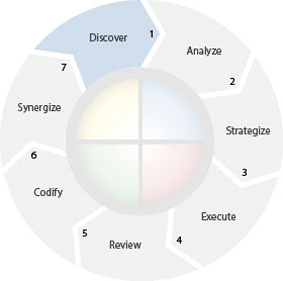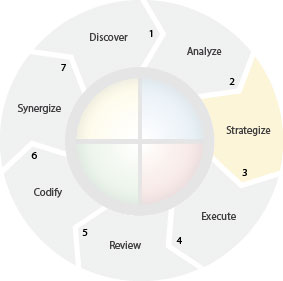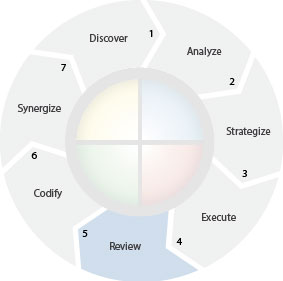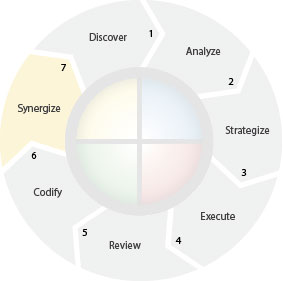
The Leader's Journey™ is a process, which leverages more than seven decades of research we have conducted on leaders and how they develop. Our methodology is a framework that has been proven across a wide spectrum of industries. World-class leaders in business, government, academic institutions, social enterprises, and faith-based organizations have experienced the results of the Leader's Journey paradigm first hand.
Most coaching models focus on behavioral change. That is, modification of a leader's behavior through hard work and effort. The approach assumes that "effort equals results." And often starts with the belief that we can become "whoever we want to be" and do "whatever we want to do" with enough effort. At Keirsey, we do believe in "effort" and we do believe in "results." However, we believe that in order to attain distinctive, substantial and enduring results that a leader's efforts need to be allocated strategically. In other words, we believe that not all desired outcomes are to be pursued.
Deciding where to invest your time, energy, and resources is complex.
Although we believe that leaders can be "good" or even "great" at many things, fundamentally, we believe that each leader has certain areas where they can be absolutely "brilliant" or be one of the "best" in their field. The Leader's Journey philosophy is that leaders ought to focus on areas where they have potential to be brilliant/best, rather than on areas where they can be good/great.




Instead of coaching for behavioral change, Leader's Journey helps you to identify and maximize your greatest strengths. By identifying your natural, inborn talents, we help you become more of who you were meant to be—by tapping into more of who you already are. We recognize that you are unique as a leader, and that your developmental path for growth as a leader is not the same as another leader. Every leader who goes through the Leader's Journey does so with different objectives, goals, and outcomes.
The leadership development strategy we take with you takes into account your leadership history, present circumstances, and growth goals. The Leader's Journey coaching process is a uniquely designed framework to help you successfully reach your intended objectives. We facilitate you through seven stages to reach a strategic outcome. The seven stages of the Leader's Journey process are here below.

In this first stage, the process involves a deep inquiry into the life of the individual leader. This stage, in essence is to understand the leader's inborn temperament, leadership experience, style, scale of influence and their perceived area of need. We have a leader reflect on their journey thus far, through a series of assessments, questionnaires and interviews. Our goal in this stage is to discover the leader's distinctive make up by defining their reality and discovering a starting point.

In this second stage, we analyze and make sense of all the information gathered during discovery. This stage, in essence is an interpretation of the leader's present life and future. It is a collaborative process between the coach and the leader, where analysis is conducted on the potential direction for the coaching engagement. Our goal in this stage is to identify the significant issues that will be focused on through the coaching process.

In this third stage, we develop a set of specific objectives, and set strategic outcomes for the individual to achieve through the coaching process. This stage, in essence is about creating the unique vision and mission for the coaching engagement. The coach and the leader agree on a strategic plan which will govern the direction, pace, and tone of the engagement. Our goal in this stage is to build a strategy to reach our objectives, and set benchmarks to assess progress.

In this fourth stage, we execute the strategy that was planned. This stage, in essence is to take action on the mission to fully realize the vision. During this stage the coach keeps the client accountable to live out the strategy in daily life. Both the coach and the leader take whatever steps are necessary to follow through, and maintain the momentum of the engagement. Our goal in this stage is to effectively carry out the plans which were set.

In this fifth stage, we assess progress in order to make any necessary adjustments. This stage, in essence is very much like a half time report, where there are opportunities to reevaluate, regroup, and reset. This is the stage where we pause to see if the execution is being carried out effectively. We want to make sure that the execution will continue to lead toward reaching the vision. Our goal in this stage is to make sure that the targets we are hitting are aligned to the vision.

In this sixth stage, we carefully examine and articulate the reasons for success and failure throughout the process. This stage, in essence is where we capture the leadership insights gained through the experience. It is where we take the key learning insights, and make them tangible by codifying them in writing. Our goal in this stage is to help the leader define their philosophy or approach to the particular issue that we have worked through during the coaching engagement.

In this seventh stage, we have the leader take what they have learned and mentor someone else. This stage, in essence is where the leader solidifies their experience. It is the stage where we can really measure whether the leader has internalized their development. Our goal in this stage is for the leader to be able to develop in someone else, what was developed in them during the whole process. This is the true test of whether the leader has made strides in their own leadership.